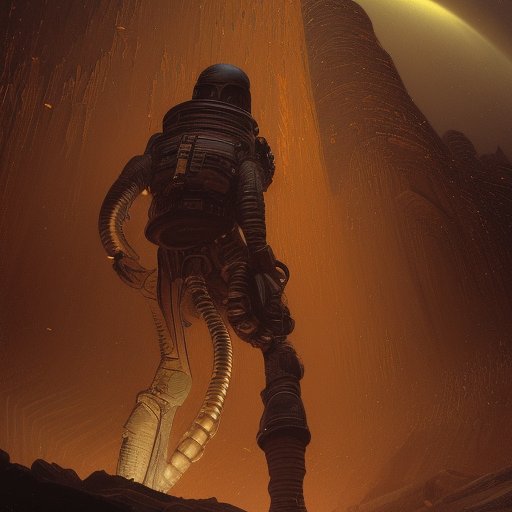
Greetings fellow intergalactic enthusiasts! The future is here with 3D printing in zero gravity. This technological marvel brings a new paradigm to space manufacturing, with its unique benefits including lower production costs and faster print times. Complex designs and intricate shapes can be printed with precision, allowing physical models to be created in space in a matter of hours. The applications of 3D printing in zero gravity are vast and encompass numerous space missions from spacecraft to space habitats for humans. While challenges do exist, such as the need for specialized equipment and materials, the future of 3D printing in zero gravity is bright and promising. Join us on this journey as we explore this bold new territory!
I. Introduction
Picture it folks, the vast and infinite expanse of space, where humanity has ventured out, boldly going where no one has gone before. Imagine a future where we can build structures in space, where we can create the technology to sustain human life and explore new worlds. But how do we build in zero gravity? Well, ponder no further, as 3D printing in zero gravity has arrived to save the day.

The idea of 3D printing in zero gravity isn’t a new concept, but the advancements we’ve made over the past decade are astonishing. Traditional manufacturing processes on Earth can be cumbersome and expensive, but in the zero gravity environment, 3D printing is a game-changer.
The technology behind 3D printing in zero gravity is an engineering marvel. In this process, melted polymer is extruded through a nozzle and then cooled and solidified into whatever shape the designers want. The beauty of 3D printing in zero gravity is that it doesn’t rely on gravity to hold its shape, like its Earth-bound counterpart. Instead, the printer can create complex structures that defy the laws of gravity and physics.
The applications of 3D printing in zero gravity are numerous. Imagine, for example, printing a space station in orbit, using the very materials we find in space. Or printing parts and tools for spacecraft or even printing human organs and tissues for long space missions.
However, it’s not all smooth sailing in the zero gravity environment. There are challenges and limitations that must be addressed, like the effect of microgravity on the printing process and the safety concerns related to printing in a confined space. These are issues that scientists and engineers are currently working to overcome.
The possibilities are endless for 3D printing in zero gravity, the technology is with us, and we are ready to embark on a new era of space exploration. Let’s boldly print where no one has printed before!
II. The Science of 3D Printing in Zero Gravity
Science geeks, listen up! If you want to create something in space, you need to understand the science behind 3D printing in zero gravity. So prepare your brain for some mind-bending concepts.

The core of the 3D printing process involves the movement of molten polymer through a melting chamber, into an extrusion nozzle, and finally, out of the nozzle onto a build platform. In the microgravity environment of space, things get trickier because there isn’t any gravity to pull the molten polymer downward. Therefore, forcing material through the extrusion system requires alternative techniques to create the motion needed.
To solve this problem, designing the printer heads so that they rely on pneumatic pressure is one solution currently being experimented with. The machines use compressed air to execute well-timed and appropriate motion. Additionally, side to side motion can also be applied to maintain uniformity and even distribution of the material.
Another challenge is depositing the melted material precisely onto the build platforms. Indeed, the microgravity environment drastically changes the behavior of the material. And so, the physics of deposition are harder to understand. 3D printers in zero gravity environments struggle to maintain the overall shape and thickness of the strands. However, scientists and engineers have come up with an effective solution. They use a force called electrostatic coalescence. It occurs when the polymer strands retain a charging effect, similar to conductive materials. This electrostatic force enables the molten metal to maintain its shape and thickness during the processing.
Last, the 3D printing process also changes the mechanical properties of the material used in building structures, thereby adding another layer of complexity to space printing. As a result, careful experimentation must be done to understand the effects of different variables such as layer thickness or temperature, so that the printing process can create strong, reliable structures.
III. Advantages of 3D Printing in Zero Gravity
Ah, the advantages of 3D printing in zero gravity! To start, let’s talk about the freedom of design that 3D printing in zero gravity affords. Producing complex geometries with traditional manufacturing processes on Earth can be limiting, but in zero gravity, anything is possible. This means that engineers and designers can innovate and create designs that would have been impossible to produce under Earth’s gravity constraints.

Another advantage of 3D printing in zero gravity is the reduction in weight and space. Printing objects and materials in space eliminates the need to launch them from Earth, which can be incredibly expensive. This also means that missions can be designed with smaller spacecraft, reducing the environmental impact of space travel.
But that’s not all! One of the most significant advantages of 3D printing in zero gravity is the ability to use resources available in space. With the right technology and resources, the printer can extrude materials made from recycled spacecraft parts or even harvest materials from asteroids or the moon.
This way, astronauts can manufacture parts and objects on demand, without having to wait for a resupply mission. This eliminates the need for mass amounts of spare parts, which would have taken up precious cargo space.
And let’s talk about time. 3D printing in zero gravity is fast! Materials are printed in seconds, rather than days or weeks with traditional manufacturing processes on Earth.
To sum up, 3D printing in zero gravity is an incredible advancement, opening up new possibilities for space exploration and reducing our dependence on Earth to print objects and materials. With its innovative designs, reduction in weight and space, and the ability to use resources available in space, 3D printing in zero gravity is revolutionizing the way we look at space exploration.
IV. Potential Applications of 3D Printing in Zero Gravity
One of the most exciting aspects of 3D printing in zero gravity is its potential applications. So, let’s take a closer look at what we could achieve with this technology in the future.

Firstly, one of the most interesting applications is the creation of space habitats. With 3D printing, we could print entire space stations, housing, research labs, and even colonies in space. The ability to construct these structures in space itself, using materials readily accessible to us, could greatly reduce the cost of constructing and launching elaborate space stations.
Secondly, 3D printing could be used to repair or build new space-based infrastructure, including antennae, solar power arrays, and other equipment. This would reduce the need to send manned missions into space to perform these repairs.
Thirdly, 3D printing can be used to create spare parts in space. When an astronaut breaks something, they could request a new part to be printed, saving the need to make costly and lengthy supply runs back to Earth or other stations in orbit.
The fourth application of 3D printing is in the aerospace industry. It can be utilized to print spacecraft, engine parts, rocket nozzles, and other aerospace components. This would greatly reduce the time and cost of constructing these items on Earth and then shipping them into space. Additionally, the 3D-printed parts may be even lighter and stronger than traditional components.
Lastly, 3D printing could be used to produce human organs in space. Long-term missions in space pose a significant threat to the health of the astronauts. The lack of gravity, radiation exposure, and other stress factors in space can cause physiological changes in human organs. The ability to produce lab-grown tissues and organs could revolutionize space medicine and contribute to long-term space travel.
All in all, 3D printing in zero gravity has already shown great promise in various applications, and the technology is continuously evolving. These potential applications of 3D printing in zero gravity could shape the future of space travel and human life beyond Earth.
V. Challenges and Limitations of 3D Printing in Zero Gravity
But as we hurtle towards the future, we can’t forget that 3D printing in zero gravity comes with some unique challenges and limitations.

For one, microgravity can make the printing process more challenging. Without the familiar pull of gravity, melted polymer can form differently, and it’s challenging to control the size and shape of the printed object. Scientists are working tirelessly to find ways around this problem, but it’s no easy feat.
Another issue is the limited space available on spacecraft. Building a printer that can handle all the variables involved in printing in zero gravity while also fitting into a small space is a tall order. The printer must be sturdy enough to survive the rigors of space travel while also producing large, accurate prints.
Safety is also a big concern when printing in zero gravity. A stray particle can quickly become disastrous in the confines of a spacecraft, causing damage to equipment or even endangering human life. That’s why scientists are working to develop printers that can operate with minimal human input, limiting the risks involved.
Despite these obstacles, the potential applications of 3D printing in zero gravity are too important to ignore. We must continue working to overcome these challenges, because the rewards are too great. With the ability to create objects in space, humanity will be able to take the next step in our exploration of the universe.
VI. Future of 3D Printing in Zero Gravity
The future of 3D printing in zero gravity is bright, my friends. The technology is still in its infancy, but the possibilities are infinite. The demand for this technology will increase as we venture further into space and explore new worlds. The 3D printers in space will need to be more robust and efficient than those on Earth, and future advancements will focus on this.

The construction of space habitats and spacecraft in space will become more accessible with the use of 3D printing. We can build complex structures with ease, such as space stations, bases, and satellites. Scientists are currently experimenting with 3D printing with different types of materials, such as metal, rock, and regolith. By using materials in the environment found in space, we can reduce the amount of material we need to carry with us, making it more cost-effective and sustainable.
The medical field will also benefit from this technology, as it becomes possible to 3D print organs and tissues in a zero gravity environment, reducing the risk of contamination and making the printing process more efficient.
The future may see the establishment of permanent off-world colonies, where people can reside, and 3D printing will have played a massive role in making this a reality. Future space missions could see astronauts utilizing 3D printing to create repairs and replacement parts, making the missions more self-sufficient and efficient.
VII. Conclusion
So, in conclusion, fellow space enthusiasts, 3D printing in zero gravity is the next big advancement that will take us to the stars. We can now print structures, tools, and even organs in space, using the very materials we find there. With 3D printing in zero gravity, we can push the boundaries of space exploration and create viable habitats for humans beyond our home planet. It’s a feat that was once thought impossible, but now, thanks to advancements in technology, it’s a reality that we can boldly embrace.

The possibilities of this technology are limitless, and we have the power to shape the future of space. We can dream of a day when we print entire cities on the moon or on Mars, terraform planets, and build habitats that can sustain human life for generations to come. The only limit is our imagination and our will to explore the unknown.
So, let’s not hesitate. Let’s boldly print where no one has printed before, and pave the way for a bright future in space. We have the technology, the know-how, and the enthusiasm to take on this challenge. All we have to do is look up at the stars, dream big and set our sights on new horizons. The space age has only just begun, and with 3D printing in zero gravity, we are poised to take the next giant leap for humankind.






